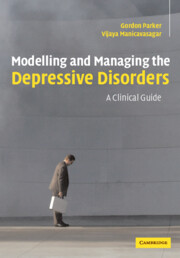Book contents
- Frontmatter
- Contents
- Acknowledgements
- Introduction
- Part I The current model for depressive disorders and its impact on clinical management
- Part II The diagnosis and management of melancholic and psychotic depression
- Part III An introduction to non-melancholic depression
- Part IV Modelling and managing the non-melancholic depressive disorders
- 13 Acute stress-related non-melancholic depression
- 14 Acute stress-related non-melancholic depression: ‘key and lock’ model
- 15 Chronic stress-related non-melancholic depression
- 16 The perfectionist personality style and non-melancholic depression
- 17 Irritability and non-melancholic depression
- 18 Anxious worrying and non-melancholic depression
- 19 Social avoidance and non-melancholic depression
- 20 Personal reserve and non-melancholic depression
- 21 Rejection sensitivity and non-melancholic depression
- 22 Self-focused personality style and non-melancholic depression
- 23 Self-criticism and non-melancholic depression
- 24 Natural and alternative treatments for non-melancholic depression
- Appendix 1 The DMI-18 and the DMI-10
- Appendix 2 The CORE system of measuring psychomotor disturbance
- Appendix 3 The temperament and personality measure
- References
- Index
21 - Rejection sensitivity and non-melancholic depression
from Part IV - Modelling and managing the non-melancholic depressive disorders
Published online by Cambridge University Press: 17 August 2009
- Frontmatter
- Contents
- Acknowledgements
- Introduction
- Part I The current model for depressive disorders and its impact on clinical management
- Part II The diagnosis and management of melancholic and psychotic depression
- Part III An introduction to non-melancholic depression
- Part IV Modelling and managing the non-melancholic depressive disorders
- 13 Acute stress-related non-melancholic depression
- 14 Acute stress-related non-melancholic depression: ‘key and lock’ model
- 15 Chronic stress-related non-melancholic depression
- 16 The perfectionist personality style and non-melancholic depression
- 17 Irritability and non-melancholic depression
- 18 Anxious worrying and non-melancholic depression
- 19 Social avoidance and non-melancholic depression
- 20 Personal reserve and non-melancholic depression
- 21 Rejection sensitivity and non-melancholic depression
- 22 Self-focused personality style and non-melancholic depression
- 23 Self-criticism and non-melancholic depression
- 24 Natural and alternative treatments for non-melancholic depression
- Appendix 1 The DMI-18 and the DMI-10
- Appendix 2 The CORE system of measuring psychomotor disturbance
- Appendix 3 The temperament and personality measure
- References
- Index
Summary
Rejection sensitivity style
This personality style is characterised by a tendency to worry about being rejected or abandoned by others. Key characteristics include being acutely tuned in to others' emotional needs and prone to feeling rejected. People with features of this personality style also tend to base their self-worth on others' perceptions of them and worry about the quality of their relationships with others. Although they may recognise that they tend to ‘lose themselves’ in relationships and become too attached, they are generally unable to prevent such pathological types of attachments from forming. As a direct result of their fears of abandonment, people with characteristics of the rejection sensitivity personality style may act in ways to please others at the expense of their own emotional health. Often, they may engage in and persist with abusive or dangerous relationships with others rather than leave the relationship altogether.
Key features of the Rejection Sensitivity Personality Style (derived from our Temperament and Personality Questionnaire):
Worries about the quality of their relationships.
Worries about being rejected or abandoned by others.
Fears that their relationships may end.
Feels as if their emotions are not reciprocated in relationships.
Worries about what others think.
Distressed about being alone.
When they experience difficulties in their relationships, such individuals may report feelings of intense emptiness and despair.
- Type
- Chapter
- Information
- Modelling and Managing the Depressive DisordersA Clinical Guide, pp. 183 - 192Publisher: Cambridge University PressPrint publication year: 2005



